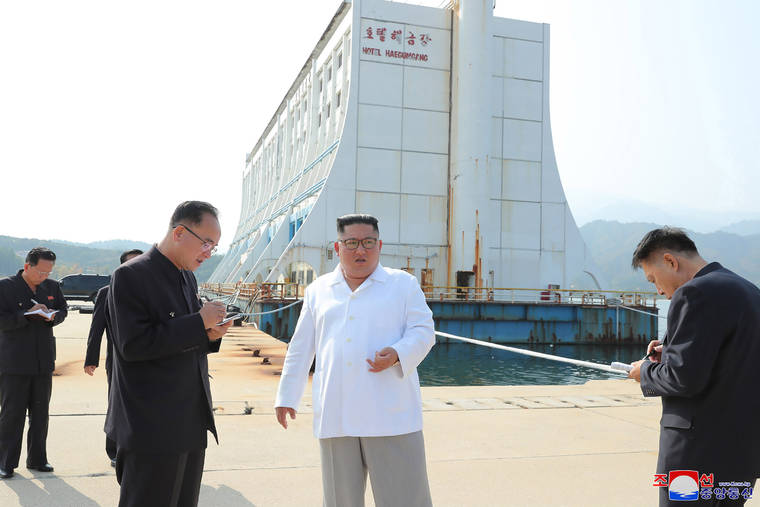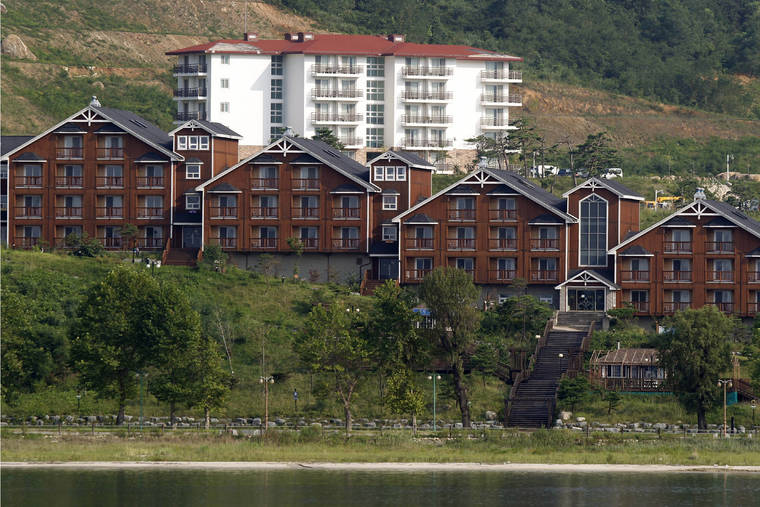SEOUL, South Korea — North Korean leader Kim Jong Un ordered the destruction of South Korean-made hotels and other tourist facilities at the North’s Diamond Mountain resort, apparently because Seoul won’t defy international sanctions and resume South Korean tours at the site.
Pyongyang’s official Korean Central News Agency said Wednesday that Kim had visited the resort and described its facilities as “shabby” and lacking national character. The report said Kim criticized North Korea’s policies pushed under his late father as too dependent on the South and vowed that the North would redevelop the site on its own.
Kim’s comments came during a prolonged freeze in relations with Seoul and are a major setback to liberal South Korean President Moon Jae-in, who met Kim three times last year while expressing ambitions to reboot inter-Korean economic engagement.
The prospects for that has dimmed amid a standstill in nuclear negotiations between Washington and Pyongyang, which faltered after the collapse of a February summit between Kim and President Donald Trump where the Americans rejected the North’s demands for broad sanctions relief in exchange for a partial surrender of its nuclear capabilities.
The United States and North Korea resumed working-level discussions Sweden earlier this month, but the talks broke down amid acrimony.
South Korean officials held back direct criticism on Kim’s remarks, saying they need to take a closer look at the North’s intent.
Lee Sang-min, spokesman of Seoul’s Unification Ministry, said the South will “actively defend the property rights of our people” and plans to accept any proposed talks by North Korea over the facilities. He didn’t offer a specific answer when asked whether the South could do anything to stop the North if it begins to tear down the facilities unilaterally.
Experts say it wasn’t immediately clear whether North Korea is really intending to independently develop tourism at Diamond Mountain or trying to dial up pressure on the South to restart the tours and upgrade the aging facilities.
Tours to Diamond Mountain were a major symbol of cooperation between the Koreas before the South suspended them in 2008 after a North Korean guard fatally shot a South Korean tourist there.
Seoul can’t restart inter-Korean economic activities without defying U.S.-led international sanctions against Pyongyang, which have been strengthened since 2016 when the North began speeding up its nuclear development.
Kim instructed officials to entirely remove the “unpleasant-looking facilities” built by the South after discussing the matter with South Korean officials and construct “new modern service facilities our own way that go well with the natural scenery of Mt. Kumgang,” the KCNA said.
“(Kim) said that the buildings are just a hotchpotch with no national character at all, and that they were built like makeshift tents in a disaster-stricken area or isolation wards,” the agency said.
“He said that due to the mistaken policy of the predecessors who tried to get benefits without any efforts after just offering the tourist area, the mountain was left uncared for more than ten years … He made a sharp criticism of the very wrong, dependent policy of the predecessors who were going to rely on others when the country was not strong enough.”
South Korea’s government and companies have built about a dozen tourist facilities in the Diamond Mountain area to accommodate the tours that began in 1998. North Korea said it took steps to freeze and confiscate all South Korean properties at the resort in 2010 and 2011 after blaming Seoul for the continued suspension in tours.
Eerily silent now are the Kumgangsan Hotel, with its theater, karaoke room, mountain murals and crystal chandeliers, as well as the resort’s restaurants, spas and golf course. The resort drew only a fraction of the 500,000 tourists projected to come annually and it lost millions of dollars for the South Korean investors.
Lim Soo-ho, an analyst from South Korea’s Institute for National Security Strategy, a think tank affiliated with Seoul’s main spy agency, said the North would struggle mightily to develop the area without the help of the South considering its lack of resources.
Tourism at Diamond Mountain, on the eastern coast near the inter-Korean border, will always mainly depend on South Korean travelers as North Korea’s poor transportation links make it difficult to bring Chinese visitors there, Lim said.
“Kim wants to develop a huge tourism region that encompasses Diamond Mountain and (the eastern coastal town of) Wonsan, but it would require the construction of major transport infrastructures to move tourists from the newly built Wonsan Kalma Airport to the Diamond Mountain area,” he said. “That would be extremely difficult under current sanctions.”
In a summit last September in Pyongyang, Kim and Moon vowed to restart South Korean tours to Diamond Mountain and normalize operations at an inter-Korean factory park in the North Korean border town of Kaesong, voicing optimism that U.S.-led sanctions could end and allow such projects.
Kim raised the subject again during his New Year’s speech this year, saying that Pyongyang was ready to restart the projects “without any precondition” while making a nationalistic call for stronger cooperation between the Koreas.
But without a breakthrough in the nuclear talks, the economic projects remain shelved, and North Korea has suspended virtually all diplomacy and cooperation with the South while demanding Seoul break away from its ally Washington and restart inter-Korean economic activities.







